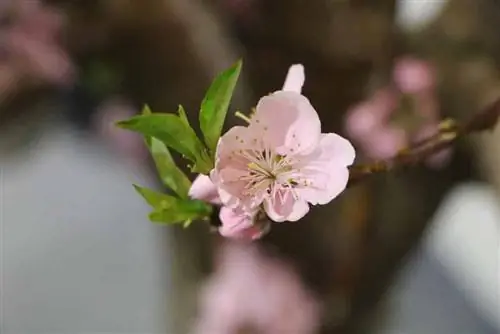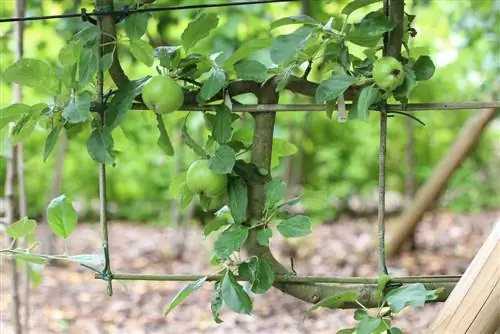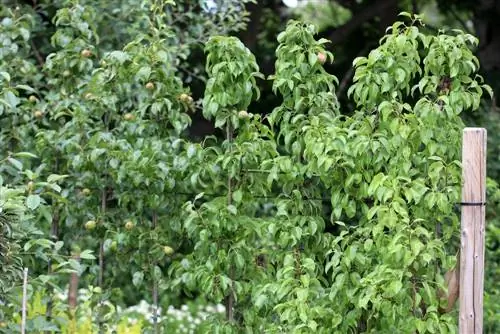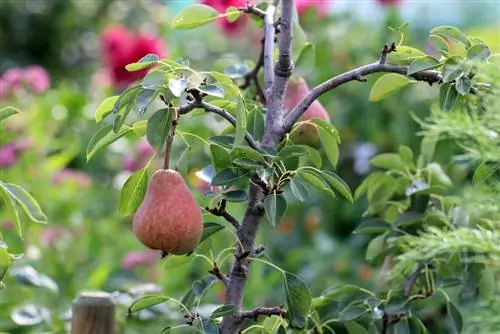- Author admin [email protected].
- Public 2023-12-17 03:39.
- Last modified 2025-01-24 12:45.
Dwarf fruit trees are fruit trees that reach a maximum height of 100 - 125 cm due to grafting or a genetic defect. For this reason, these dwarf fruit trees can be grown both in your own garden or as a pot plant and offer a fruit yield even in the smallest of spaces. The resulting fruits are of normal size, but due to the size of the tree, the harvest will of course be smaller.
Caring for the dwarf fruit tree
A dwarf fruit tree that is used freely in the garden does not require much more care than a normal fruit tree of the same type. Nutrient-rich soil and a sunny parking space are completely sufficient. However, if a dwarf fruit tree is kept in a flower pot, there are a few factors to consider when caring for the tree. First of all, you need to choose a flower pot that is large enough to provide enough space for the roots of the tree. 30 liters have proven to be a good guideline.
In addition, the flower pot must have an appropriately large drain so that waterlogging cannot form and excess water can drain away quickly. It is advisable to apply a thin layer of gravel (3-5 cm) to the bottom of the pot to improve drainage. The soil for the dwarf fruit tree should consist of a good mixture of normal potting soil, planting substrate and a pinch of sand to ensure an optimal supply of nutrients. To ensure a long-term supply of nutrients, a certain amount of horn shavings can also be added to the soil.
Before potting the dwarf fruit tree, its roots must be adapted to the pot. The roots should be trimmed so that they have 3-5 cm of space to all edges of the pot. However, be careful when cutting the roots, as this cut also affects the shape of the crown. If thick and strong roots are pruned too much, the dwarf fruit tree will hardly be able to form thick branches, especially at the beginning, and will remain very delicate in structure. Such a dwarf fruit tree should be repotted every 3-5 years, whereby the soil should of course be completely replaced. An annual replacement of the soil only needs to be done superficially so that new nutrients can be introduced into the soil. Fertilizing the tree can be done in different ways. Regardless of whether you use organic or mineral fertilizer, fertilization should be carried out until August at the latest in order not to endanger the hardening of the wood before winter.
Important points for the dwarf fruit tree:
- Appropriate flower pot size (min. 30 l)
- A nutrient-rich substrate
- Guarantee water drainage of the plant pot
- Don't bend the roots and cut them carefully
- Repotting every 3-5 years
- Fertilize until August at most
Pruning the dwarf fruit tree
When pruning dwarf fruit trees, various techniques are used, which are used both in conventional fruit growing and in bonsai care. It is also important here that the first cut takes place before sprouting. Especially in contrast to normal fruit tree pruning, it can be said that dwarf fruit trees need to be cut shorter and more regularly than their larger relatives. What is particularly important are the requirements for the cut. All branches that cross each other, run parallel or do not grow in an outward direction are cut. This ensures the best possible supply of the remaining branches and creates a dense and, above all, productive crown of the dwarf fruit tree. The cut is always made directly above a bud. There is a specific reason for this. Only the parts of the tree with a bud at the end are supplied with nutrients. If you cut the tree between two buds, the part after the first bud dies and rots on the trunk. This is an entry point for pathogens and pests and can therefore cause serious damage to the tree.
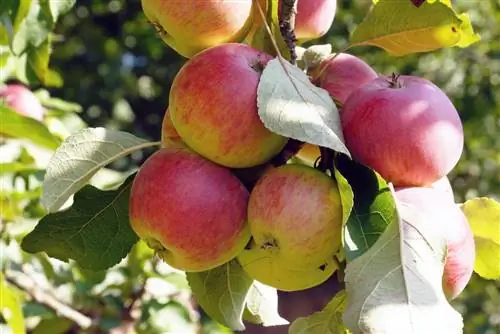
Large cut surfaces should therefore be sealed with wound closure agents or latex, even on a dwarf fruit tree. However, in order to ensure that the branches are as thick as possible, especially in the lower area of the crown, they must not be cut for a long period of time. Only after they have reached the desired thickness should a cut be made here. This usually requires a lot of patience from the gardener and can initially make the appearance of the dwarf fruit tree a little uneven. It is important to pay attention to the fruit buds when cutting. If you want to get a high yield from the tree, you may have to accept some visual cuts, as the fruit-bearing branches cannot be cut. The cut should also be carried out until August at the latest so that the tree can harden the wood in autumn without having to deal with cuts.
Pruning of dwarf fruit trees:
- Cut regularly
- Always cut directly behind the bud
- sealing large wounds
- cut back incorrectly growing branches early
- Prune the trees until August at the latest.
Everyone who lives in a small rental apartment in the big city wants their own garden with their own fruit trees. Until a few years ago, this wish was practically impossible to fulfill. For some time now, so-called dwarf fruit trees have been enjoying increasing popularity.
What you need to know about the dwarf fruit tree
But why is the dwarf apple tree so small? Basically, the entire growth of the small tree is the same as that of the large apple tree. Just keep everything in small form. No matter whether you want to keep a small apple tree, cherry tree, pear tree or nectarine tree on the balcony, every fruit tree is now also available in a small version.
Due to a genetic defect, the dwarf fruit trees only grow to a height of between 100 and 120 cm. However, this short stature does not interfere with the fruit. They are almost exactly the same size as those on a normal fruit tree. You only have to compromise on the quantity of small trees due to the lack of space.
Care tips
- the bigger the pot is, the more comfortable the fruit tree will feel
- place the pot on small feet so that too much water - be it irrigation water or rainwater - can drain away unhindered
- Water evaporation through the leaves is almost as high as in large trees. It is therefore essential to ensure sufficient irrigation.
- A dwarf fruit tree feels most comfortable in normal potting soil, but high-quality roof and trough soil can also be used.
- As a little tip, the plant owner should mix some sand into the soil so that the tree contains enough minerals.



